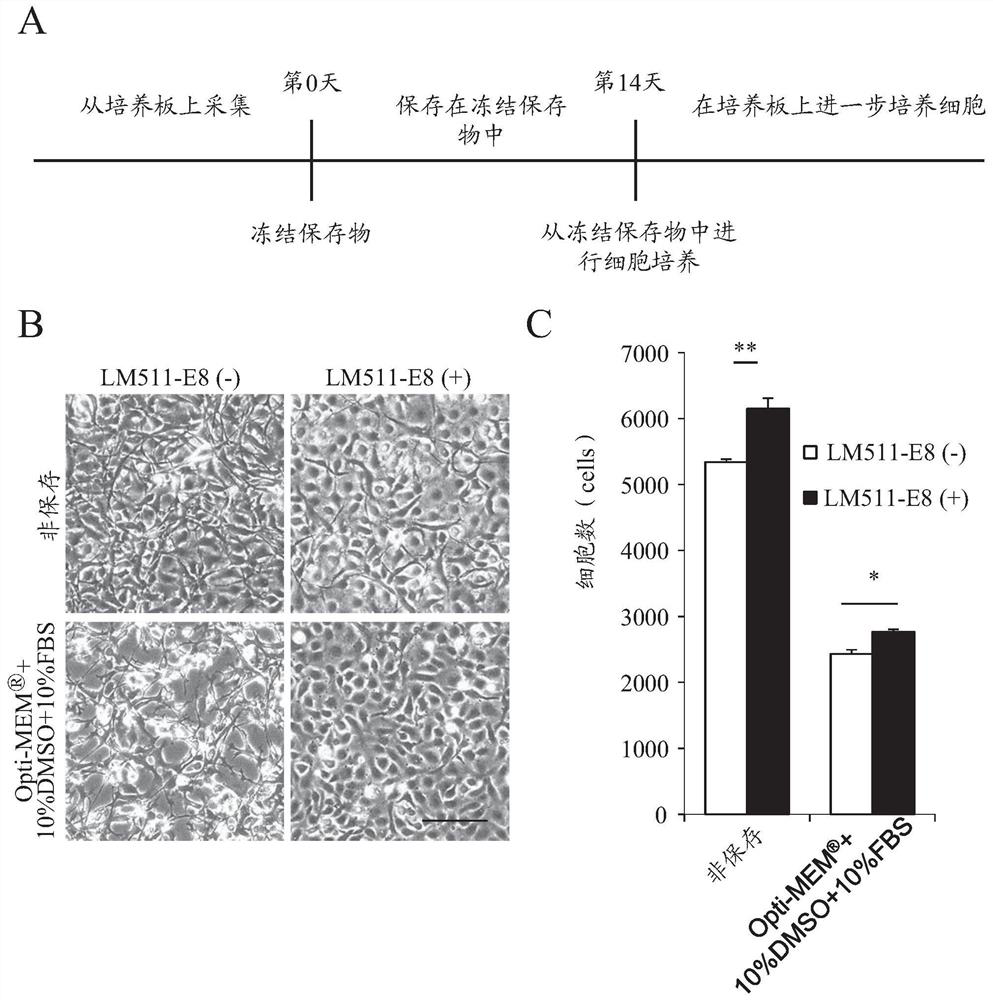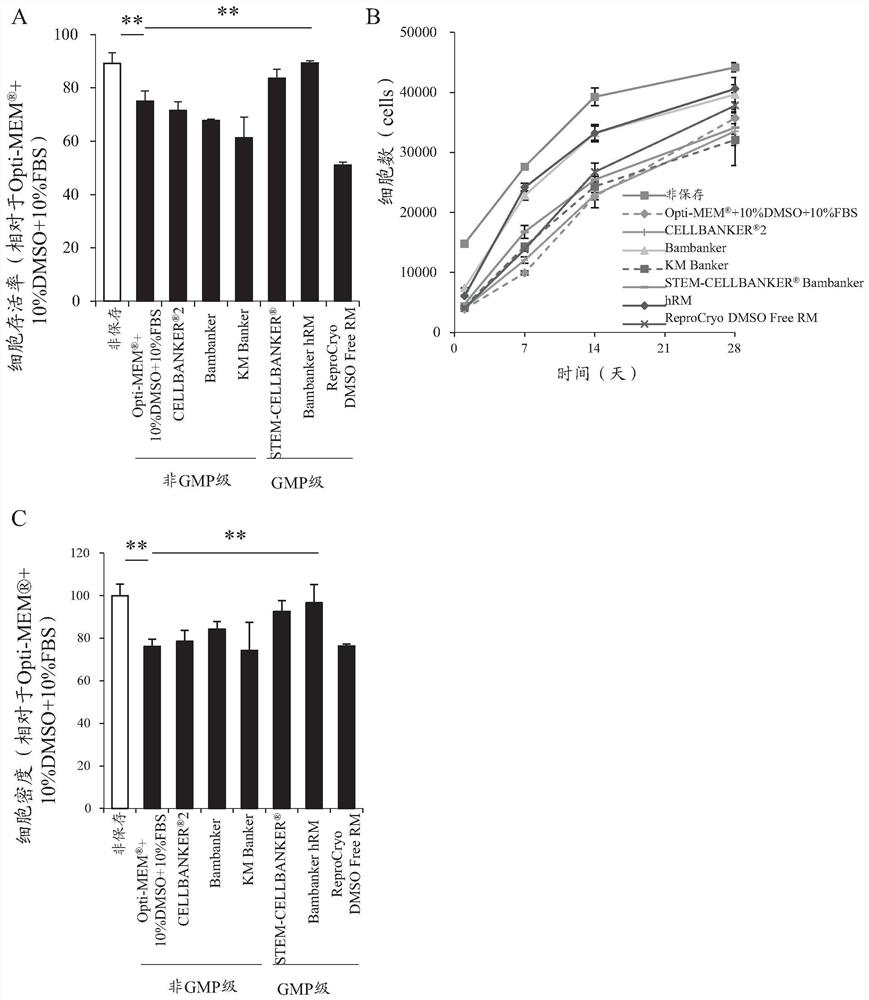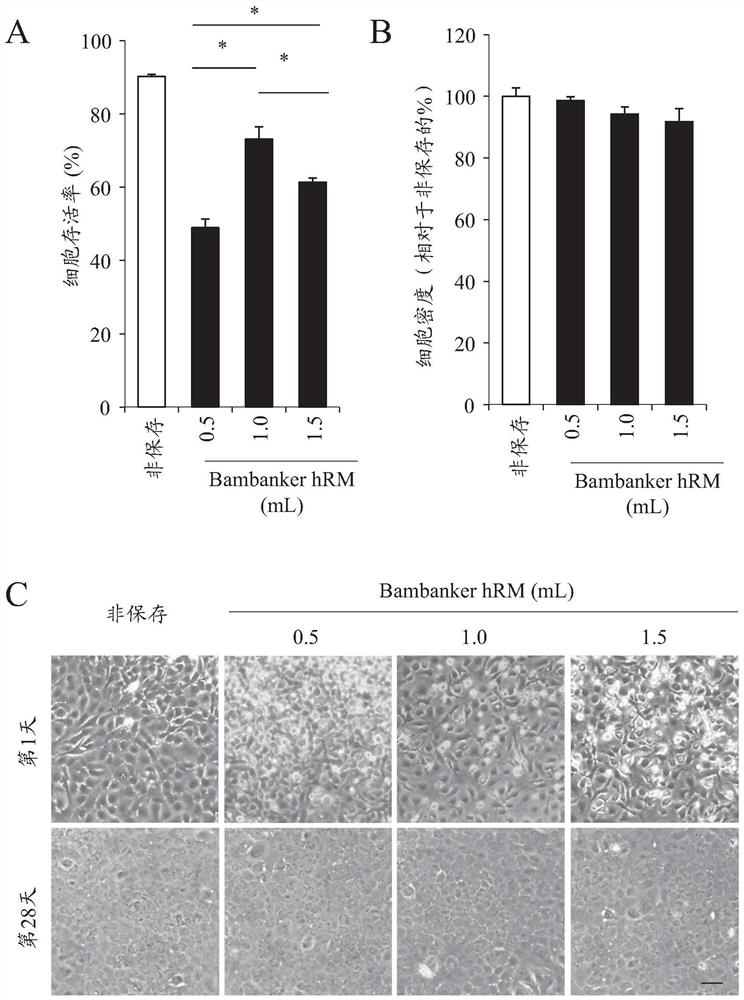Composition and method for preserving or culturing ocular cells
A composition and cell technology, applied in cell culture supports/coatings, biochemical equipment and methods, animal cells, etc., can solve the problems of insufficient donors, rejection, surgical invasion, etc., to improve work efficiency, cell The effect of increasing the number
- Summary
- Abstract
- Description
- Claims
- Application Information
AI Technical Summary
Problems solved by technology
Method used
Image
Examples
Embodiment 1
[0282] (Example 1: Screening of frozen preservation solution)
[0283] In this example, the cryopreservation solution suitable for cryopreservation of corneal endothelial cells was screened.
[0284] (A cell survival rate)
[0285] Thaw the cryopreservation tube containing human corneal endothelial cells in a water bath at 37°C for 1-2 minutes. Human corneal endothelial cells were recovered with basal medium preheated to 37°C. Subsequently, the human corneal endothelial cells were centrifuged at 190G for 5 minutes, the supernatant was removed, and the human corneal endothelial cells were suspended in the culture medium. Subsequently, dead cells were stained with 0.5%-Trypan Blue Stain solution (Nacalai Tesque, 29853-34) for 10 minutes. Use a hemocytometer to measure the number of viable cells and dead cells. For cells that have been frozen and preserved, divide the number of viable cells by the number of preserved cells (5 × 10 5 ), to calculate the cell survival rate, and...
Embodiment 2
[0296] (Example 2: Liquid volume research of preservation solution)
[0297] In this example, the appropriate amount of cryopreservation solution used for cryopreservation was studied.
[0298] (A cell survival rate)
[0299] The medium was removed from the culture dish for culturing human corneal endothelial cells, and 1×PBS(-) (Nissui Fen Co., Ltd., 05913) preheated to 37° C. was added for washing. This operation was repeated 2 times. Add 1×PBS(-) again, at 37°C (5% CO 2 ) for 3 minutes. After removing PBS(-), add TrypLE TM Select Enzyme (10X) (ThermoFisher Scientific, A1217701), at 37°C (5% CO 2 ) for 15 minutes. Subsequently, the cells were recovered by being suspended in a medium and centrifuged at 280G for 3 minutes. After counting the number of cells, the suspension was dispensed into 15ml centrifuge tubes and centrifuged at 280G for 3 minutes. After removing the supernatant, add 0.5ml, 1ml, 1.5ml of frozen storage reagents to reach 5×10 per 1ml respectively. 5...
Embodiment 3
[0310] (Example 3: Evaluation of cryopreservation of high-density cells)
[0311] (A cell survival rate)
[0312] In order to evaluate the feasibility of the cryopreservation protocol, as cells for clinical use, the number of passages is 3 to 5 and the cell density is 2000 cells / mm 2 The above cells were based on the quality that can be used in clinical practice, and the effect of Bambanker hRM on cell preservation was studied. The medium was removed from the culture dish for culturing human corneal endothelial cells, and 1×PBS(-) (Nissui Fen Co., Ltd., 05913) preheated to 37° C. was added for washing. This operation was repeated 2 times. Add 1×PBS(-) again, at 37°C (5% CO 2 ) for 3 minutes. After removing PBS(-), add TrypLE TM SelectEnzyme (10X) (Thermo Fisher Scientific, A1217701), at 37°C (5% CO 2 ) for 15 minutes. Subsequently, the cells were recovered by being suspended in a medium and centrifuged at 280G for 3 minutes. After counting the number of cells, the huma...
PUM
 Login to View More
Login to View More Abstract
Description
Claims
Application Information
 Login to View More
Login to View More - R&D
- Intellectual Property
- Life Sciences
- Materials
- Tech Scout
- Unparalleled Data Quality
- Higher Quality Content
- 60% Fewer Hallucinations
Browse by: Latest US Patents, China's latest patents, Technical Efficacy Thesaurus, Application Domain, Technology Topic, Popular Technical Reports.
© 2025 PatSnap. All rights reserved.Legal|Privacy policy|Modern Slavery Act Transparency Statement|Sitemap|About US| Contact US: help@patsnap.com



